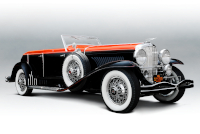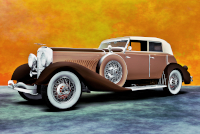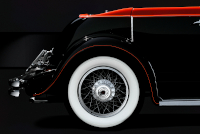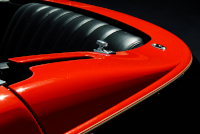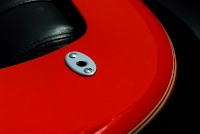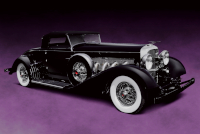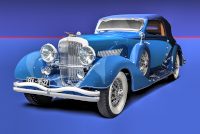Location:
Elegance at Hershey, 2012
Owner: Sonny & Joan Abagnale | Cedar Grove, New Jersey
Prologue:
In my humble opinion, black and vermilion are the true classic American automotive colors, much of which we owe to Duesenberg. This Riviera Phaeton captures that classic spirit, which is why I wanted to profile this car early among Duesenbergs, before embarking on an in-depth portfolio. I figured the departure would be quick. But then in Fred Roe's 1982 book, "Duesenberg: The Pursuit of Perfection," I found a photo of J-440 with reference to its modified running gear. That piqued my curiosity, and I soon dug up a picture of the modified car from the Blackhawk Collection. I like to create photo-illustrations of lost variations, and with extra stock from the left quarter perspective, here I found a perfect opportunity.
Years ago I first worked up the main image, which, for this profile, needed only subtle tweaks to get rolling again. But of course the complete effort increased exponentially once I settled on doing this lost-version illustration, and then dug into some additional snaps. So the draft became a more involved interjection than I anticipated, a lengthy sideline while building the Pierce-Arrow portfolio.
Those who visited these Hershey shows will also recognize a familiar overhead perspective snapped from the terrace, accessible from the hotel's dining room. E provided a good template for this bird's eye view while I skulked around below. Altogether, we offer some uncommon perspectives on J-440, though I admit if we run across the car again I might be tempted to collect enough stock to illustrate its interstitial Cherokee red configuration, as owned by Frank Lloyd Wright's son-in-law.
- - - - - - - - - -
► Image Source: Nikon D200 (10.2 MP) | Image Source 4 by E, illustrated by the author.
References:
- Roe, Fred. "Duesenberg: The Pursuit of Perfection" Dalton Watson Plc, London, UK. 1982, page 202
- RM Auctions: See the 2011 Monterey auction listing for J-440, which includes full owner history.
- Gooding & Company: A brief entry for J-440 from Pebble Beach, 2006.
- Coachbuild: As ever, fine history on Bohman & Schwartz.
- Frank Lloyd Wright Foundation: "Willey House Stories Part 11 - Origin of Wright's Cherokee Red" by Steve Sikora, February 22, 2019
As Duesenbergs so often change over the years, there are three versions of this Riviera Phaeton. The car is chassis #2550, which originally ran J-521, and it is one of three Riviera Phaetons produced by Brunn. The version depicted in the main image is the original configuration, as restored by Fran Roxas and Brian Joseph.
Prior to its original-spec restoration, the car received red paint under the ownership of Frank Lloyd Wright's son-in-law, complement to Wright's own Cherokee red classics. Later, during a 1967 restoration, the car received major alterations by the junior Chris Bohman, creating the version illustrated in our second image.
However the car has been prepared, J-440 is one of the better proportioned Model J design exercises. The standard Model J chassis are so long that both two and four-door styles often do not manage the wheelbase expanse without some awkwardness. A Duesenberg in profile often draws attention to its over-grand scale. But the Riviera Phaeton uses the shorter 142.5-inch wheelbase for a four-door car, and therefore better uses the available length.
J-440 is also among those Model J exercises of a nautical persuasion. Whether by its Riviera moniker or the heavy-clad gunnel around the passenger compartment, the design reads as a steel skiff. But the ingenuity (and bother) lies in the fully retractable hood, a trend explored early in the classic era both in the US and Europe.
The car's owner history is long, beginning with a San Francisco attorney. Photos of the car appear in Fred Roe's Duesenberg history (without Bohman modifications), and recent auctions and concours events have popularized this chassis among the three originally built. All the more worthwhile, the black and vermilion livery is vintage Duesenberg—the unofficially official livery of the marque. In this case, the application over the bonnet, gunnels, and pinstripes creates contrast enough to glamorize the disappearing top design.
Motor: 6,876 cc (420 cubic inch) straight 8-cylinder, cast iron block and head | 95.3 mm x 120.7 mm | 5.2:1 compression
RM notes that Duesenberg originally fitted motor J-521 to chassis #2550. Roe confirms J-521 matches #2550, and that chassis #2448 used J-440.
Valvetrain: DOHC, 4 valves per cylinder
Power: 265 bhp @ 4,200 rpm
Automobile Quarterly notes that a very early production sample of the Lycoming straight 8-cylinder produced 208 bhp at 3,600 rpm, (pushed no further, as the motor had been scrapped by the factory). Projecting the power curve to 4,200 rpm, the motor's eventual top end, would yield between 245 to 250 brake horsepower, which means the motor's development worked out reasonably in favor of the 265 bhp claimed for production cars, if not a reliable 250 bhp when sorted. Compression for the early scrapped motor equals the production motors at 5.2:1.
Front Suspension: solid axle with semi-elliptic leafsprings and hydraulic shock abosorbers
Rear Suspension: live axle with semi-elliptic leafsprings and hydraulic shock absorbers
Architecture: steel ladder-frame chassis with coachwork by Brunn & Company of Buffalo, New York
Wheelbase: 3,619.5 mm (142.5 inches)
Etymology:
Duesenberg identification follows the Lycoming straight 8-cylinder motor, in this case J-440, whereas the chassis is #2550.
Figures:
Our favorite online index listed more than 460 Model J Duesenbergs. Automobile Quarterly supposed Duesenberg produced between 470 and 480. RM suggest 481 known examples. Of the lot, Brunn built three Riviera Phaetons. All three survive.
Value:
J-440 sold at RM's 2011 Monterey auction for $990,000. Previously, the car sold at Gooding & Company's 2006 Pebble Beach auction for $1,210,000.
Riviera Phaeton: A Four-Door Convertible Touring Car
Fred Roe describes the design as follows: "As an open car, the Brunn Riviera offered a trim appearance as the top was completely concealed. To achieve this look the fabric around the rear quarter must be completely unsnapped and first folded forward so that the entire hinged rear deck can be opened to expose the compartment in which to store the top."
No short process, but as early as 1929 both American and continental designers looked for ways to conceal the hood when not in use. Murphy created the disappearing top roadster, a popular two-door style for the Model J. In Europe, Pourtout bodied Lancia and Peugeot models with retractable hard tops. The Riviera Phaeton extends this concept to a four-door touring car. While grand with the hood up, the car's completely open passenger compartment looks svelte with the hood stowed.
The Riviera name recalls yachting and its associated glamour, identifying J-440 as a pleasure craft. Formally, the back hatch provides a tidy tail end and stylish treatment around the gunnel, not unlike a period motor yacht. Piano hinges stand out strong against the black paint, enhancing the hatch aesthetic by dividing the flank into three sections with no spacing between. The car owes its fine proportions to a slightly shorter wheelbase than most four-door styles used, creating a piece that is equal to many two-door Model J styles. The result is one of the best proportioned Duesenbergs.
Bohman Conversion: Late J-440 Updates by Chris Bohman
Some sources comment that the fully skirted running gear stems from Bohman & Schwartz. But the conversion took place during a 1967 restoration under the guidance of Chris Bohman (as C. Bohman & Son), well after the dissolution of Bohman & Schwartz. And so the Chris in question is the son, Lawrence Christian Bohman, who operated the firm after his father's passing in 1950. All the better to give some service to the post-War update, because the livery and lines are purely classic. But this latest development is rather the third incarnation of the original design.
Second Incarnation: The Taliesen Red Car
The second version is not so much a design alteration as a mood. Frank Lloyd Wright’s son-in-law, William Wesley Peters, purchased the Riviera Brunn sometime in the early post-War period. He painted the car a color most describe as Taliesin red, but that would be properly known as Cherokee red. True, Cherokee red is the color of Taliesin West, though the hue changed over the years. Neither is J-440 the only family classic to wear Frank Lloyd Wright's signature red paint. Wright's own 1937 AC 16/18 Competition Sports survives today with what we might presume is the same color. In any case, using the Taliesin name automatically references Wright, whereas Cherokee red may not at first glance.
Last Updated: Mar 26, 2025

